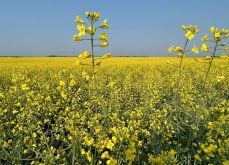Producers wonder if canola breeders need to focus more on finding a solution to heat stress and its impact on yields
WINNIPEG — The yield gap between spring wheat and canola is substantial this fall in western Manitoba.
In some instances, the gap is 30 bushels per acre.
The Manitoba Agriculture crop report for Oct. 2 says the average spring wheat yield in the northwest region of the province is 65 to 70 bu. per acre.
Read Also

Huge Black Sea flax crop to provide stiff competition
Russia and Kazakhstan harvested huge flax crops and will be providing stiff competition in China and the EU.
Meanwhile, canola yields are lower than previous years.
“Average yields so far have been approximately 30 to 40 bu. per acre,” says the crop report.
Jocelyn Velestuk, SaskWheat vice-chair, also saw a yield gap on her farm in eastern Saskatchewan near Broadview — maybe not 25 to 30 bu. but a significant difference between spring wheat and canola.
“Yes, the same thing happened out in Saskatchewan,” she said.
“Last year it (the yield gap) was much closer and we had less moisture. You’re scratching your head. What happened?”
Yield estimates from Alberta are showing a 15 bu. difference between spring wheat and canola.
In central Alberta, where conditions were dry for much of the summer, the Alberta crop report says canola is averaging 28 bu. per acre.
Spring wheat in central Alberta is posting 45 bu. per acre, or 17 bu. more than canola.
The estimates from the 2024 growing season illustrate a difference between the two crops that occupy nearly 40 million acres of farmland in Western Canada.
Spring wheat yields seem more resilient, particularly in years with hotter and drier growing conditions. The Environment Canada weather station at the Regina airport recorded 13 days with temperatures above 30 C in July. Those hot and dry days hammered canola, but many wheat crops withstood the scorching period of summer weather.
“The plant breeding that has gone into wheat is phenomenal,” Velestuk said.
“As farmers, we need the yield and the quality (from spring wheat). It seems like an impossible thing, but we’re getting it year after year.”
It’s become obvious to Velestuk, and many other farmers, that the canola industry needs a solution or partial solution to heat stress and the impact on yield.
She’s curious about plot research done this growing season and whether certain hybrids are more tolerant of 32 C days and 20 C nights.
“There may be differences in different varieties,” she said.
“Maybe someone would have data from their plots this year.”
Possibly, canola breeding efforts need to focus more on yield stability and developing hybrids that are adapted to the drier regions of Western Canada.
“In the southwest and more southern Saskatchewan, they’ve been having a hard time with canola,” Velestuk said.
“We want everyone to be able to grow canola everywhere (on the Prairies) because it can be a great money maker.”
As for wheat, Velestuk is encouraging the federal government to maintain public plant breeding and varietal development within Agriculture Canada.
“That’s one success that’s come out of government…. That is one system that works well.”


















